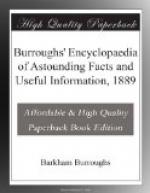COUNTERFEIT AND GENUINE WORK.
[Illustration: DETECTING COUNTERFEIT MONEY]
As indicated above, counterfeit notes are issued and put into the channels of circulation in abundance every year by those engaged in the practice of counterfeiting. These notes are often such good imitations of the genuine that it is quite difficult to discern the difference.
That he may protect himself, each business man should have some definite knowledge of a genuine bank-note.
The engraving of a genuine bank note, in most all of its parts, is done by machinery, and it is more exact and perfect. On the contrary, most all parts of counterfeit notes are done by hand.
Counterfeiters cannot afford to purchase machinery, such as is used for the production of genuine notes. The cost of such machinery is between $100,000, and $150,000, and if it were in wrong hands it would be always liable to seizure and confiscation.
In order to prevent the forgery of bank-notes, a great deal of ingenuity and art has been expended on their production. The principal features of the manufacture are described as a peculiar kind of paper and water mark; an elaborate design, printed with a peculiar kind of ink, and certain private marks, known only by the bank officials.
The work of counterfeiters can never equal that of the makers of genuine notes, whose skill and facilities for producing the highest grade of work known to the art, are the best that the world affords.
Unless one is somewhat learned as to the quality of engraving, that he may be able to distinguish a fine specimen of the art when he sees it, he is likely to become a victim of the counterfeiter’s operations.
LATHE WORK.
When the genuineness of a bank-note is doubted, the Lathe Work on the note should first be closely scrutinized. The several letters of denomination, circles, ovals, and shadings between and around the letters in the words, etc., are composed of numberless extremely fine lines—inclusive of lines straight, curved and network. These are all regular and unbroken, never running into each other, and may be traced throughout with a magnifying glass.
Without the skill or machinery, by which the genuine is produced, the same quality of work cannot be done. Therefore, in a counterfeit, the lines are imperfect, giving the paper a dull or hazy aspect, that may be all the better appreciated by comparing it with the genuine. The lines in the counterfeit will be found now and then irregular in size, and broken: not uniform in course, sometimes heavy, sometimes light: no two stamps or dies on the same note being exactly alike.
The fine, uniform, shade-lines, with which the letters on the genuine are embellished, are wrought by a machine that cannot be reproduced by counterfeiters, nor used for other than legitimate purposes, by authority.




